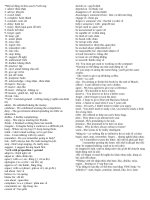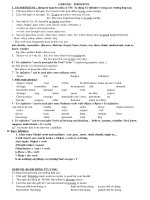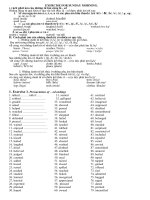ìninitives and gerund
Bạn đang xem bản rút gọn của tài liệu. Xem và tải ngay bản đầy đủ của tài liệu tại đây (338.67 KB, 14 trang )
Welcome to my lesson
Welcome to my lesson
This lesson will talk to you how
This lesson will talk to you how
to use infinitives and gerund
to use infinitives and gerund
Động từ dùng làm tân ngữ
Không phải bất cứ động từ nào trong
tiếng Anh cũng đều đòi hỏi tân ngữ
đứng sau nó là một danh từ. Một số
các động từ lại đòi hỏi tân ngữ sau nó
phải là một động từ khác. Động từ làm
tân ngữ được chia làm hai loại:
•
Loại 1: Động từ nguyên thể là tân
ngữ (to + inf)
•
Loại 2: Động từ V-ing dùng làm tân
ngữ
1.
1.
Verb+ to-inf
Verb+ to-inf
•
To-inf following these verb:
want, decide, hope, promise, manage, agree, threaten, offer, attempt, fail,
plan, appear, seem, pretend, afford, learn, tend, dare, ask, expect,
choose, demand, determine, happen, hesitate, neglect, prove, prepare,
swear, volunteer, wish, consent, care, beg, aim, trouble, refuse, would
like/ love/ hate/ prefer.
Ex: 1. What do you want to do?
I hope to go to university next year.
2. I would like to meet you.
•
To-inf after question words (what, where, why, how)
Ex: 1.We asked how to drive a car.
2.Have you decided where to go for holiday?
• Some structures with to-inf
It’s nice/ kind/ good/ stupid/ + to-inf
Ex It’s nice to meet you.
It’s+ adj+ to-inf
Ex It’s interesting to read this book.
S+ to be+ too+ adj+ to-in
Ex He’s too short to reach this shelf.
Note: Trong câu phủ định, thêm not vào trước động từ làm tân ngữ.
Ex Lan decided not to buy this car.
•
Động từ đi sau tính từ:
Một số tính từ theo sau bởi to-inf
anxious boring dangerous hard
eager easy good strange
pleased prepared ready able
usual common difficult
1.It is dangerous to drive in this weather.
2.Mike is anxious to see his family.
3.We are ready to leave now.
4.It is difficult to pass this test.
•Note: able và capable có nghĩa như nhau nhưng cách dùng khác nhau:
(able/ unable) to do smt = (capable/ incapable) of doing smt.









